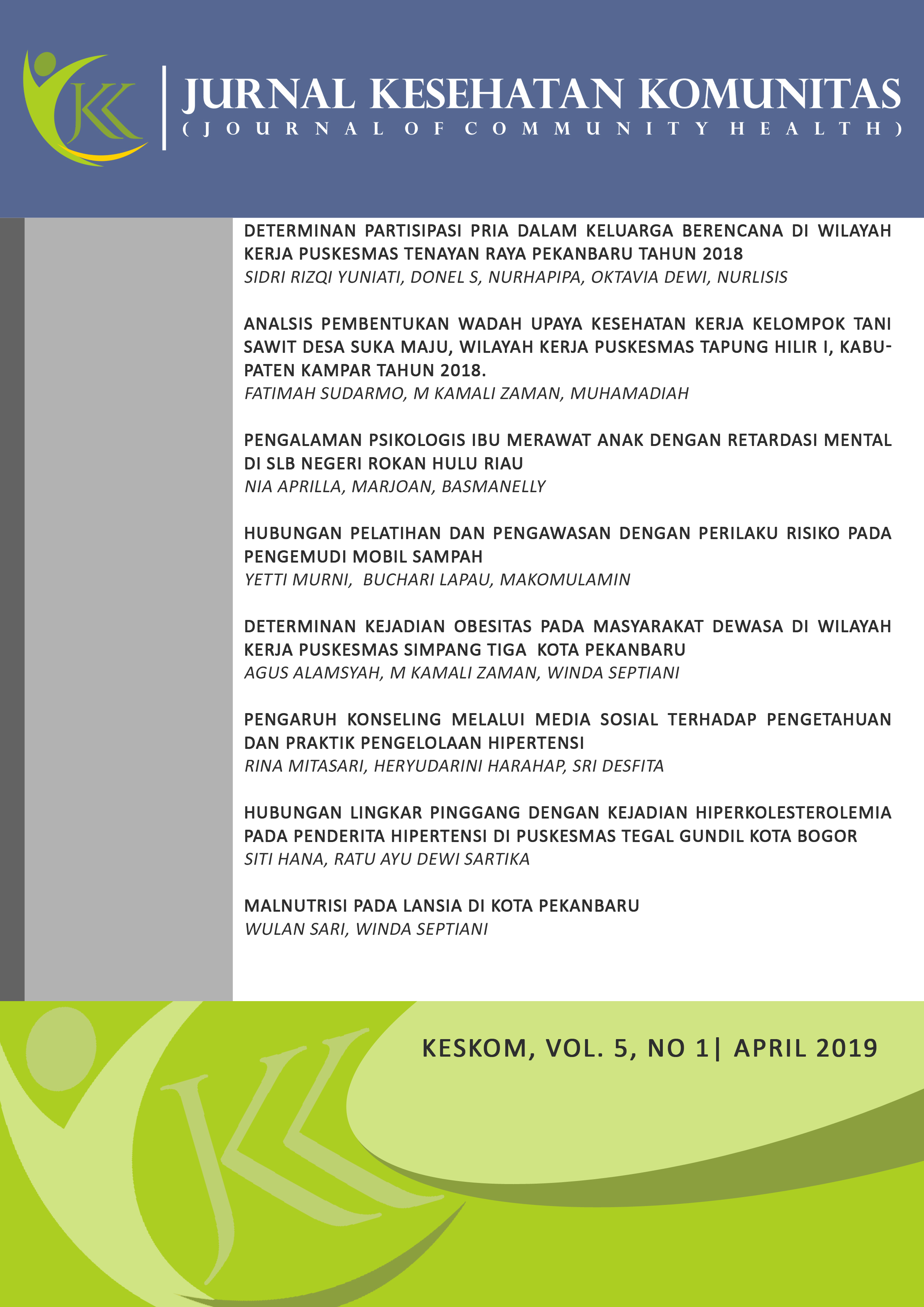Determinants of men’s participation in family planning in the working area of Health Centre Tenayan Raya
Determinan Partisipasi Pria Dalam Keluarga Berencana Di Wilayah Kerja Puskesmas Tenayan Raya Pekanbaru Tahun 2018
DOI:
https://doi.org/10.25311/keskom.Vol5.Iss1.279Keywords:
Family Planning, Men Couples of childbearing age, participationAbstract
A family planning program is a program to help couples or someone to prevent unwanted pregnancies and reduce the incidence of high-risk pregnancies, morbidity, and mortality, create quality and affordable services, increase male participation and responsibility in family planning practices. The purpose of this study was to determine the determinants of male participation in family planning.
Methods: This research is quantitative analytic using an observational method with a type of case-control design. This study was conducted in August-September 2018 in the working area of the inpatient health care center. The population of all men of childbearing age who are in the working area of the puskesmas is the large population of the case population of 712 people and the control population of 21,480 people.Research sample of 360 men couples of reproductive age divided into 2 groups, namely the case 180 group and the control group 180. purposive sampling sampling technique Data analysis was carried out in univariate, bivariate and multivariate.
Results: This research is quantitative analytic using an observational method with a type of case-control design. This study was conducted in August-September 2018 in the working area of the inpatient health care center. The population of all men of childbearing age who are in the working area of the puskesmas is the large population of the case population of 712 people and the control population of 21,480 people.Research sample of 360 men couples of reproductive age divided into 2 groups, namely the case 180 group and the control group 180. purposive sampling technique Data analysis was carried out in univariate, bivariate and multivariate.
Conclusion: Conclusion The dominant variable with male participation in family planning is the attitude variable. Suggestions Health workers are expected to do more counseling about male family planning, putting up posters, and leaflets about male family planning.
Downloads
References
Adriani, L., Sutanto, Hastono, & Besral. (2016). Determinan Partisipasi Penggunaan Kontrasepsi Modern Pada Pria Kawin Usia 15-54 Tahun Di Indonesia ( Analisis Data Survei Demografi Dan Kesehatan Indonesia 2012 ). Forum Ilmiah, 13(2), 5–10.
Agadjanian, V., Hayford, S. R., Luz, L., & Yao, J. (2015). International Journal of Gynecology and Obstetrics Bridging user and provider perspectives : Family planning access and utilization in rural Mozambique. International Journal of Gynecology and Obstetrics, 130, E47–E51. https://doi.org/10.1016/j.ijgo.2015.03.019
Austin, A. (2015). Unmet contraceptive need among married Nigerian women: An examination of trends and drivers. Contraception, 91(1), 31–38. https://doi.org/10.1016/j.contraception.2014.10.002
BAPPENAS. (2014). Laporan Pelaksanaan Tugas Menteri Ppn/ Kepala Bappenas Dalam Kabinet Indonesia Bersatu II 2009-2014 Kementerian.
BKKBN. (2005). Keluarga Berencana dan Kesehatan Reproduksi. Jakarta: BKKBN.
BKKBN. (2008). Jumlah Peserta KB Aktif (PA) Terhadap PPM-PA. Jakarta.
BKKBN. (2012). Pelayanan Kontrasepsi. Jakarta: BKKBN.
BPS. (2017). Realisasi Pencapaian Peserta KB Aktif Menurut Jenis Kontrasepsi 2015. Jakarta.
Budisantoso. (2008). Faktor - Faktor yang Berhubungan dengan Partisipasi Pria dalam Keluarga Berencana di Kecamatan Jetis Kabupaten Bantul Tahun 2008. Universitas Diponegoro Semarang.
Ernawati, S. (2016). Faktor yang Memengaruhi Keluarga Berencana ( KB ) Pria dengan Paritisipasi Pria dalam Keluarga Berencana di Wilayah Kerja Puskesmas Sedayu II. Journal Ners And Midwifery Indonesia, 4(2), 109–116. Retrieved from http://ejournal.almaata.ac.id/index.php/JNKI
Handayani, F. (2014). Pertisipasi Suami Dalam Penggunaan Alat Kontrasepsi Pria Di Rw 06 Kelurahan Tuah Karya Kecamatan Tampan Kota Pekanbaru. Jurnal Kebidanan STIKes Tuanku Tambusai Riau, 5(November), 42–51.
Muhatiah, R. (2017). Partisipasi Pria Dalam Program Keluarga Berencana ( Kb ). Dinas Kesehatan Kampar, 1–18. Retrieved from ejournal.uin-suska.ac.id/index.php/marwah/article/download/502/482
Ramdani. (2013). Analisis Faktor-faktor yang Mempengaruhi Partisipasi Suami dalam Penggunaan Alat Kontrasepsi di DesaTegal RejoTamantirto Kasihan Bantul Yogyakarta.
UNFPA, & BKKBN. (2014). Survei Demografi dan Kesehatan Modul Pria. Jakarta.
Yuswatining, E., & Hariyono. (2017). Penggunaan Alat Kontrasepsi Keluarga Berencana ( Studi di RW 01 Dusun Dempok Desa Grogol Kecamatan Diwek Jombang ). In Prosiding Seminar Nasional (pp. 157–163). Jombang.
Downloads
Submitted
Accepted
Published
How to Cite
Issue
Section
License
Copyright @2017. This is an open-access article distributed under the terms of the Creative Commons Attribution-NonCommercial-ShareAlike 4.0 International License (http://creativecommons.org/licenses/by-nc-sa/4.0/) which permits unrestricted non-commercial used, distribution and reproduction in any medium












































